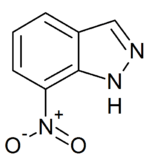7-Nitroindazole
 | |
| Names | |
|---|---|
| IUPAC name
7-nitro-1H-indazole | |
| Identifiers | |
3D model (JSmol) |
|
| ChEMBL | |
| ChemSpider | |
| ECHA InfoCard | 100.019.032 |
PubChem CID |
|
| |
| |
| Properties | |
| C7H5N3O2 | |
| Molar mass | 163.1335 |
Except where otherwise noted, data are given for materials in their standard state (at 25 °C [77 °F], 100 kPa). | |
| Infobox references | |
7-Nitroindazole, or 7-NI, is a heterocyclic small molecule containing an indazole ring that has been nitrated at the 7 position. Nitroindazole acts as a selective inhibitor for neuronal nitric oxide synthase, a hemoprotein enzyme that, in neuronal tissue, converts arginine to citrulline and nitric oxide (NO).[1] Nitric oxide can diffuse through the plasma membrane into neighbouring cells, allowing cell signalling, so nitroindazole indirectly inhibits this signalling process.[2][3][4] Other inhibitors exist such as 3-bromo-7-nitroindazole, which is more potent but less specific,[5] or NPA (N-propyl-L-arginine), which acts on a different site.[6]
Pharmacology
7-Nitroindazole is under investigation as a possible protective agent against nerve damage caused by excitotoxicity or neurodegenerative diseases.[1][7] It may act by reducing oxidative stress or by decreasing the amount of peroxynitrite formed in these tissues. These effects are related to the inhibition of type 1 nitric oxide synthase. However, anticonvulsive effect is derived from some other mechanisms.[8]
See also
- Dizocilpine (MK-801) a non-competitive antagonist of the NMDA receptor
- Sildenafil a drug for impotence, which inhibits cGMP specific phosphodiesterase type 5 (PDE5), which is responsible for degradation of cGMP, which is produced by guanylate cyclase, which is activated by nitric oxide produced by eNOS
- tetrahydrobiopterin, cofactor to several enzymes including nitric oxide synthase (NOS)
- protein kinase A (PKA) and protein kinase C (PKC)
References
- 1 2 Southan GJ; Szabó C (February 1996). "Selective pharmacological inhibition of distinct nitric oxide synthase isoforms". Biochem. Pharmacol. 51 (4): 383–94. doi:10.1016/0006-2952(95)02099-3. PMID 8619882.
- ↑ Moore PK; Wallace P; Gaffen Z; Hart SL; Babbedge RC (September 1993). "Characterization of the novel nitric oxide synthase inhibitor 7-nitro indazole and related indazoles: antinociceptive and cardiovascular effects". Br. J. Pharmacol. 110 (1): 219–24. doi:10.1111/j.1476-5381.1993.tb13795.x. PMC 2175981. PMID 7693278.
- ↑ Babbedge RC; Bland-Ward PA; Hart SL; Moore PK (September 1993). "Inhibition of rat cerebellar nitric oxide synthase by 7-nitro indazole and related substituted indazoles". Br. J. Pharmacol. 110 (1): 225–8. doi:10.1111/j.1476-5381.1993.tb13796.x. PMC 2175991. PMID 7693279.
- ↑ Moore PK; Babbedge RC; Wallace P; Gaffen ZA; Hart SL (February 1993). "7-Nitro indazole, an inhibitor of nitric oxide synthase, exhibits anti-nociceptive activity in the mouse without increasing blood pressure". Br. J. Pharmacol. 108 (2): 296–7. doi:10.1111/j.1476-5381.1993.tb12798.x. PMC 1907983. PMID 7680591.
- ↑ Gammie SC; Olaghere-da Silva UB; Nelson RJ (July 2000). "3-bromo-7-nitroindazole, a neuronal nitric oxide synthase inhibitor, impairs maternal aggression and citrulline immunoreactivity in prairie voles". Brain Res. 870 (1–2): 80–6. doi:10.1016/S0006-8993(00)02404-5. PMID 10869504.
- ↑ Kampf C; Roomans GM (May 2001). "Effects of hypochlorite on cultured respiratory epithelial cells". Free Radic. Res. 34 (5): 499–511. doi:10.1080/10715760100300441. PMID 11378533.
- ↑ Schulz JB; Matthews RT; Klockgether T; Dichgans J; Beal MF (September 1997). "The role of mitochondrial dysfunction and neuronal nitric oxide in animal models of neurodegenerative diseases". Mol. Cell. Biochem. 174 (1–2): 193–7. doi:10.1023/A:1006852306789. PMID 9309687.
- ↑ Matsumura, N.; Kikuchi-Utsumi, K.; Nakaki, T. (2008). "Activities of 7-nitroindazole and 1-(2-(trifluoromethylphenyl)-imidazole independent of neuronal nitric-oxide synthase inhibition". J Pharmacol Exp Ther. 325 (2): 357–62. doi:10.1124/jpet.107.135160. PMID 18270316.
External links
- 7-nitroindazole at the US National Library of Medicine Medical Subject Headings (MeSH)